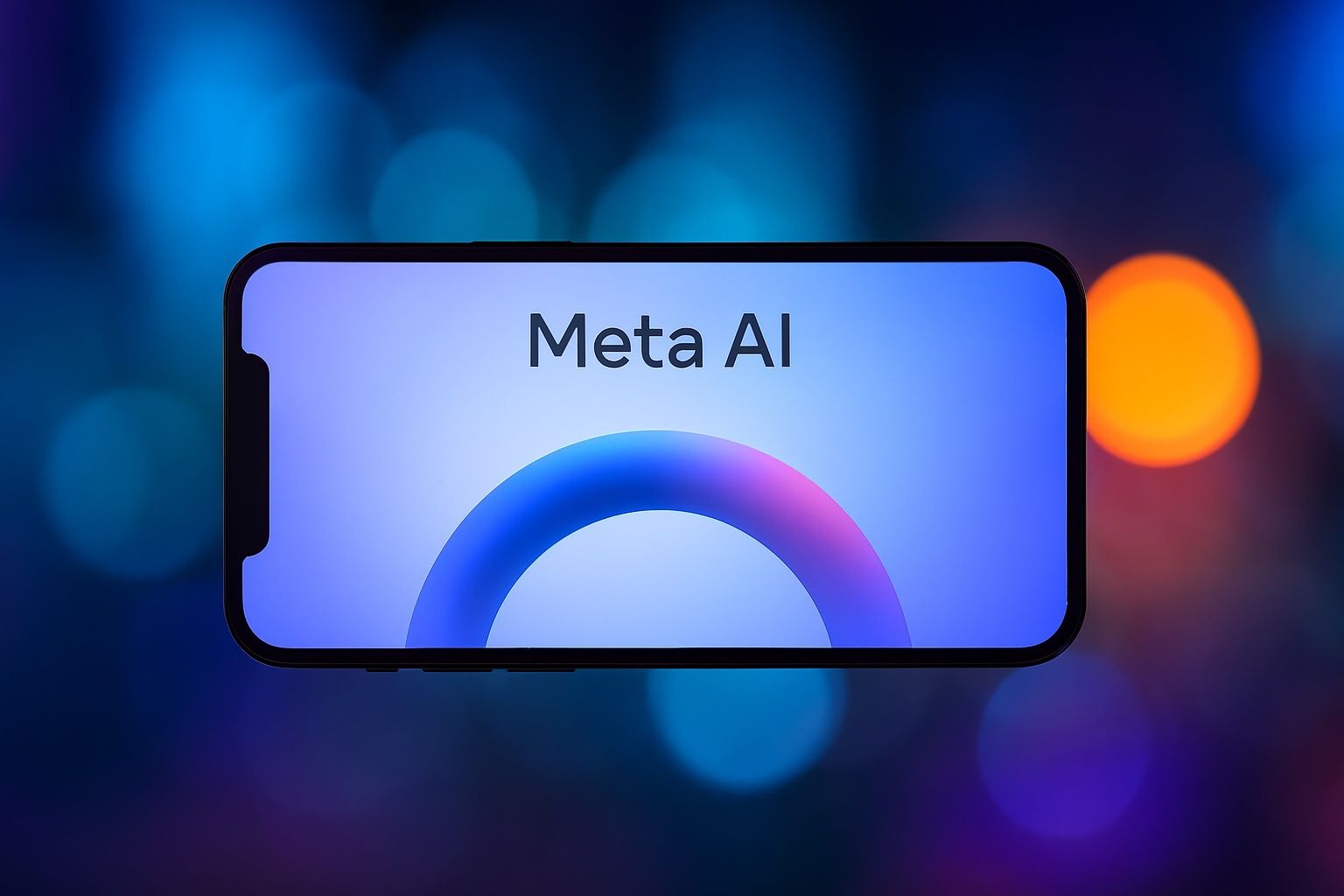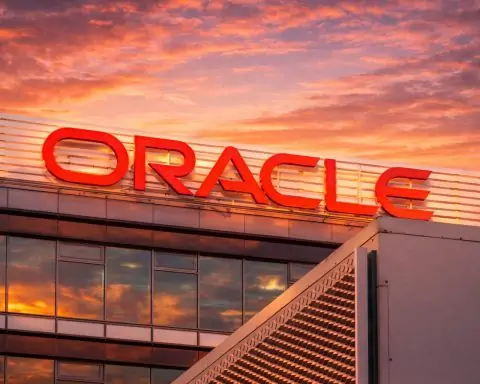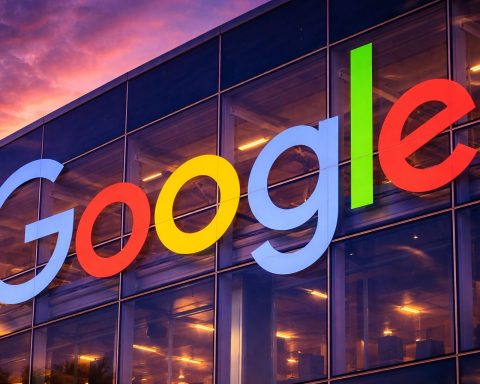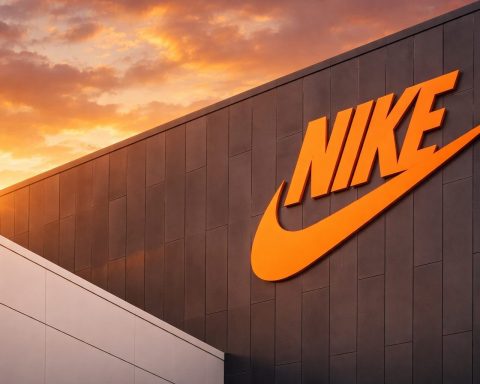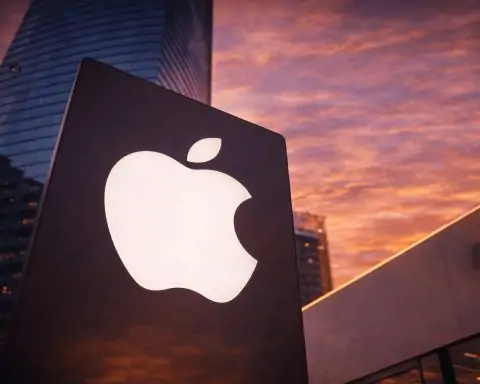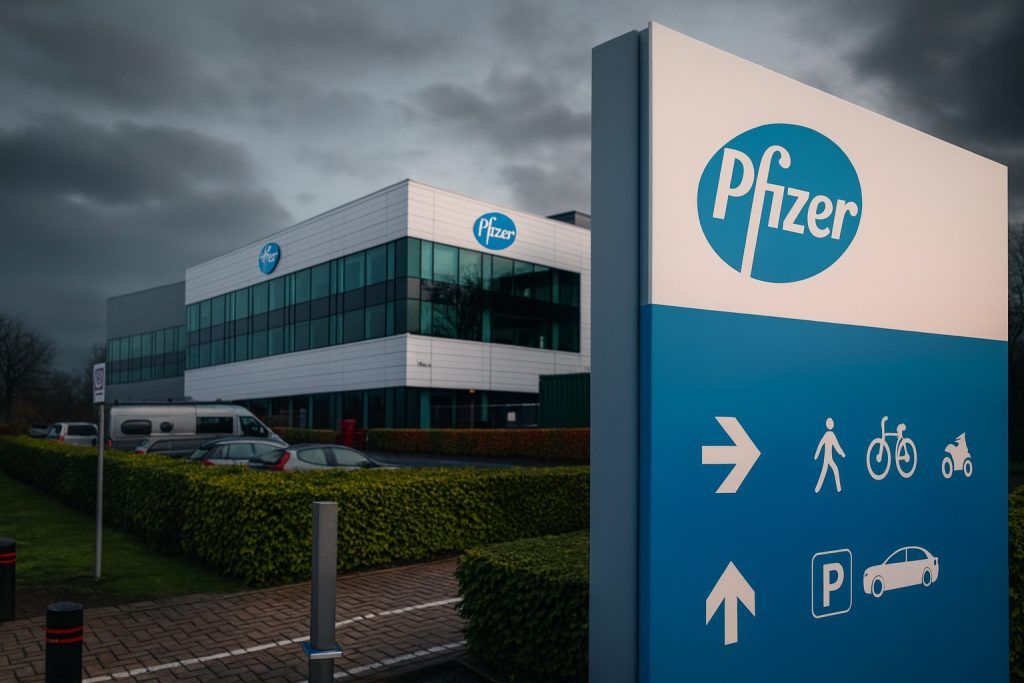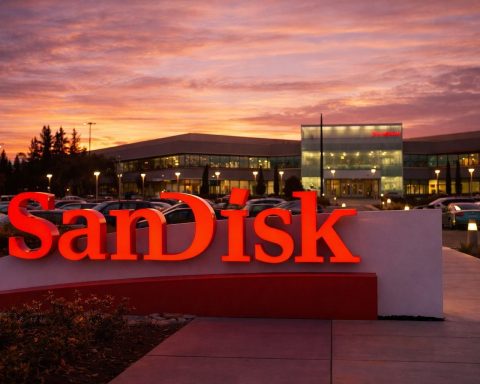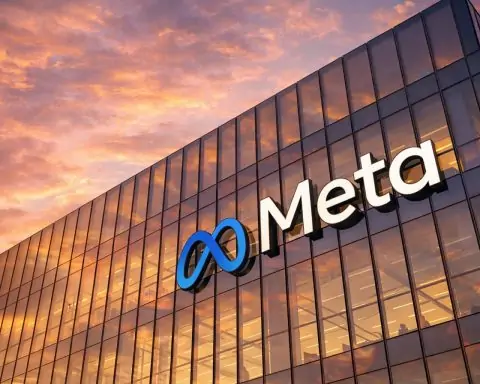- Soaring Stock: Meta Platforms (NASDAQ: META) stock trades around $700 per share as of Oct 6, 2025, up ~25% year-to-date [1]. Shares hit an all-time high of $789.47 in August before pulling back [2]. Meta’s market capitalization now exceeds $1.8 trillion [3], with a trailing P/E ~26 and forward P/E ~25 [4] – a valuation seen as reasonable relative to mega-cap peers.
- Strong Financials: The company posted robust Q2 2025 results: revenue jumped 22% YoY to $47.5 billion with a 43% operating margin [5]. Net income was $18.3 billion (up 36%) and EPS $7.14 [6]. Daily active users across Facebook, Instagram, WhatsApp, and Messenger hit 3.48 billion [7], fueling ad impressions growth of 11% and higher ad prices [8]. Meta guided for Q3 revenue of $47.5–50.5 billion and is on track for ~$199 billion in 2025 revenue (≈21% YoY growth) [9] [10].
- Analysts Bullish: Wall Street remains optimistic. 44 analysts rate META a “Strong Buy” with an average price target around $825 (median $850) [11]. Recent targets range from $810 up to $980+, with firms like Mizuho and Cantor Fitzgerald eyeing ~$920 [12]. Forbes even predicted Meta’s “bull run seems likely to bring it over the $800 mark” on strong earnings and a modest valuation versus Google or Microsoft [13]. Some forecasts envision the stock near $875 by year-end if ad growth stays robust [14].
- Major News (Early Oct 2025): Meta announced a deal to acquire Rivos, a Silicon Valley chip startup, for around $2 billion to bolster its custom AI semiconductor program [15]. On Sept 30, a U.S. judge dismissed an antitrust class-action that alleged Meta misled users on data privacy, removing a looming trial from November [16]. Meanwhile, Meta said it will use generative AI chats to personalize users’ Facebook/Instagram feeds and ads starting Dec 2025 (no opt-out) – a move to leverage its new Meta AI assistant and boost engagement [17] [18]. In Europe, regulators are tightening the screws: a Dutch court ordered Meta to give users an easy way to view a chronological feed (non-algorithmic) per the EU’s Digital Services Act [19]. Meta is appealing as it faces broader EU limits on targeted ads under the new Digital Markets Act [20].
- AI & Metaverse Drive: Meta is pouring resources into artificial intelligence and immersive platforms. It has inked multi-billion-dollar deals for AI infrastructure – e.g. a $14 billion cloud compute contract with CoreWeave [21] and a six-year Google Cloud partnership worth $10+ billion [22] – to ensure capacity for training AI models. In June, Meta even took a 49% stake in Scale AI for $14.3 billion, bringing in CEO Alexandr Wang to help lead its AI strategy [23]. On the metaverse front, Meta’s Reality Labs unit debuted its first consumer smart glasses with a built-in display (Ray-Ban Meta “Display,” $799) at the late-September Meta Connect conference [24]. CEO Mark Zuckerberg touted these AI-powered glasses as a step toward “personal superintelligence” on your face [25]. However, high-profile live demos flopped on stage (due to software bugs, not Wi-Fi), underscoring both the ambition and the technical hurdles of Meta’s AR push [26] [27].
Stock Performance & Financial Health (2025)
Meta’s stock has been on a tear in 2025, handily outperforming the broader market. The shares opened the year under $600 and, despite a spring dip, rallied to a record $789 in mid-August [28]. After a late-summer surge, the stock has cooled to the $700 range – still about 25% higher year-to-date [29]. This volatility reflects investor excitement over Meta’s AI prospects tempered by periodic profit-taking. Technicals show the stock off its highs but in a healthy uptrend (its 52-week low was $480 in April) [30] [31].
Financially, Meta is delivering impressive growth and profitability for a company of its size. In Q2 2025 it reported $47.52 billion in revenue (up 22% YoY) with 43% operating margins [32]. Ad demand rebounded strongly – ad impressions rose 11% and average prices ~9% amid improved AI-driven targeting [33]. Net income hit $18.34 billion (a hefty 38% YoY jump) [34], and trailing 12-month profit now exceeds $71 billion (an enormous 40% net margin) [35]. Meta’s profitability and cash flow remain a standout: it generated $25.6 B in operating cash in Q2 and still returned ~$9.8 B to shareholders via buybacks and even paid a $1.3 B dividend [36] [37] – a sign of confidence in its cash generation.
Valuation: Despite this growth, Meta’s multiples are not extreme for Big Tech. At ~$700/share, it trades around 25–26× forward earnings and ~10× sales [38]. Its $1.8+ trillion market cap equates to ~8% of the S&P 500. By comparison, Alphabet and Amazon have higher revenue multiples or similar P/Es [39] [40]. Meta also boasts a 40%+ return on equity with relatively low debt (debt-to-equity ~0.25) [41]. In short, investors see Meta as a growth-at-scale story – a social media empire pivoting successfully into AI – and have rewarded it with a premium, though one still below ultra-expensive peers like Nvidia or Microsoft. Analysts at StockAnalysis note Meta’s valuation is actually cheaper than Apple or Microsoft on earnings, given its higher growth, and only slightly above Alphabet’s [42].
User Base & Ads: Meta’s family of apps continues to expand its reach. Daily Active People across Facebook, Instagram, WhatsApp and Messenger hit 3.48 billion in Q2 [43] – nearly half the planet. This massive audience (especially in emerging markets) and improved engagement (e.g. time spent on Reels short videos) are fueling ad revenue despite saturation in developed regions. While younger users have more options (TikTok, Snap, etc.), Meta’s multiple apps give it unrivaled scale for advertisers. In Q2, ad revenue grew 24% YoY, helped by AI-powered content recommendations that keep users scrolling and clicking on more ads [44]. Meta has also kept a lid on costs after its 2022–23 belt-tightening (layoffs and “year of efficiency”); Q2 operating expenses rose just 12% even as revenue jumped 22% [45]. This operating leverage boosted margins and profits, reassuring investors that Meta can invest heavily in AI and the metaverse and still deliver earnings growth.
Guidance: For Q3 2025, Meta forecast revenue of $47.5–50.5 billion (roughly 20% YoY growth at the midpoint) [46]. It also maintained a full-year expense outlook of $114–118 billion and capital expenditures of $66–72 billion – a jaw-dropping spend largely “to build AI infrastructure” and fund Reality Labs’ AR/VR projects [47]. Even so, Wall Street consensus expects 2025 EPS around $28 (up ~35% from 2024) and further growth to ~$30.6 in 2026 [48]. That implies Meta is investing aggressively yet still expanding earnings. The company’s ability to sustain double-digit revenue growth at its scale is a key driver behind the stock’s momentum. As one 24/7 Wall St. report noted, Meta has even outperformed most of the other “Magnificent 7” tech stocks in 2025, thanks to its combination of high growth and high margins [49] [50].
Recent Developments (Late Sept – Oct 2025)
In the first week of October 2025, Meta grabbed headlines with a flurry of news – some bullish, some cautionary:
- Custom AI Chips – Rivos Acquisition: Meta confirmed plans to acquire Rivos, a Silicon Valley chip startup, in a deal sources value around $2 billion [51]. Rivos specializes in RISC-V based semiconductor designs. Meta’s VP of Engineering said the purchase will “accelerate our custom silicon work” [52] for AI – specifically Meta’s in-house MTIA (Meta Training and Inference Accelerator) chips that power its AI data centers. This buyout underscores Meta’s strategy to own key AI infrastructure (silicon) and reduce reliance on external GPU suppliers like Nvidia. It follows Meta’s recent hiring of top chip talent and rumors it is designing an “AI superchip” for its next-gen servers.
- Antitrust Win in Court: On Sept 30, a U.S. federal judge dismissed an antitrust class-action that claimed Facebook’s data practices harmed competition [53]. The suit alleged Meta misled users about how their data was collected and used, supposedly cementing a social media monopoly. The judge granted summary judgment to Meta, cancelling a trial set for November. Meta hailed the ruling as validation that the case lacked merit [54]. This removes one legal overhang, though Meta still faces separate antitrust battles (notably an FTC lawsuit aiming to break up the company – ongoing in federal court).
- AI Personalization of Feeds: Meta announced it will leverage users’ AI interactions to personalize content and ads across Facebook and Instagram starting December 2025 [55]. In practice, this means if a user chats with Meta’s new AI assistant about a topic (say, hiking), Meta will later show them more related posts, Reels, or even product ads for hiking gear [56]. These AI chats (via text or voice) become another signal feeding Meta’s algorithms, alongside traditional data like likes and follows. Users will be notified of the change and cannot opt out except by not using the AI features [57]. Meta clarified that sensitive topics (health, religion, etc.) from AI chats won’t be used for ads [58]. This move highlights Meta’s push to integrate generative AI deeply into its products. However, it immediately drew scrutiny from privacy regulators, and notably excludes Europe (the rollout will skip the EU, UK, and South Korea for now due to stricter data rules) [59]. Still, with 1 billion+ monthly users already engaging with Meta’s AI across its apps [60], the company is eager to turn those interactions into more tailored (and profitable) feeds.
- Meta Connect 2025 Highlights: Meta’s annual developer conference (held Sept 27, 2025) served as a launchpad for its latest hardware and AI innovations. The marquee unveiling was the Ray-Ban Meta “Display” smart glasses – Meta’s first glasses with an integrated display for AR content [61]. Priced at $799 and co-developed with Ray-Ban, these glasses can overlay texts, calls, and turn-by-turn directions in your field of view, effectively bringing a smartphone screen to your eye [62]. They come with a neural wristband controller that reads hand gestures to control the interface [63]. Mark Zuckerberg framed the product as a step toward ever-present AI assistance: “Glasses are the ideal form factor for personal superintelligence… they let you stay present in the moment while getting access to AI capabilities that make you smarter, help you communicate better, improve your memory, and more.” [64] The Connect event also introduced Meta AI chatbots (with dozens of celebrity-inspired personas for Messenger/WhatsApp) and showcased the upcoming Quest 4 VR headset improvements. Unfortunately, the live demos didn’t all go as planned. In one widely publicized snafu, an on-stage cooking demo using the AI glasses misfired – a voice command accidentally triggered every pair of glasses in the audience to respond, overloading Meta’s servers (a self-induced DDoS) [65] [66]. In another, an incoming video call caused the demo glasses’ display to freeze at the worst moment [67] [68]. Zuckerberg laughed off the “brutal Wi-Fi” and Meta’s CTO Andrew “Boz” Bosworth later explained the glitches were due to software bugs, not hardware faults [69] [70]. Despite the embarrassment, reviewers who tested the devices still came away impressed by their potential [71]. The incident did, however, fuel skepticism in some quarters (“comedy gold” for tech pundits) about whether Meta’s AR vision is ready for prime time [72].
- Europe’s Regulatory Heat: Meta’s practices are under intense scrutiny in the EU. On Oct 2, a Dutch court, citing the EU Digital Services Act (DSA), ordered Meta to change Facebook and Instagram’s timeline settings to better respect user choice [73]. The court said Meta must offer a “direct and simple” way for users to opt out of algorithmic feeds and see a chronological timeline – and importantly, once a user selects that, the apps cannot keep defaulting back to the algorithmic feed [74]. Currently, Facebook/IG make the AI-curated feed the default (and often revert to it), which the court called a harmful “dark pattern” undermining user autonomy [75]. Meta was given 2 weeks to comply in the Netherlands, ahead of national elections, to limit algorithmic influence on information exposure [76]. Meta vowed to appeal, arguing that such matters should be handled at the EU-wide level, not by individual countries [77]. This comes on top of the EU’s Digital Markets Act (DMA), effective 2024, which already compelled Meta to allow users to opt out of personalized ads and could force changes to how WhatsApp and Messenger interoperate with rivals. In short, Europe is forcing Meta to rethink core design choices – a trend that could spread globally.
- Costly Privacy Case – “Flo” Lawsuit: Meta is staring down a potential multibillion-dollar payout in a class action over privacy. In August, a San Francisco jury found Meta liable for violating user privacy by collecting health data from the Flo fertility tracking app (via hidden SDKs) without proper consent [78]. At an Oct 1 post-trial hearing, the judge indicated Meta could owe up to $8 billion in damages if the verdict stands and the plaintiffs’ requests are granted [79]. Meta is appealing, but the case is noteworthy as one of the few privacy class actions to actually go to trial (most are settled). It’s a reminder of Meta’s history of privacy stumbles – from the $5 billion FTC fine in 2019 to a $1.3 billion EU GDPR fine in 2023 and a $1.4 billion settlement with Texas in 2024 over facial recognition data [80]. The Flo verdict, if upheld, would dwarf those and set a precedent that tech firms can be hit with damages scaled to the number of users affected (in Flo’s case, tens of millions). Meta has argued that it didn’t knowingly misuse sensitive data and that Flo’s developers bore responsibility, but the legal risk here is significant.
AI Innovations and Metaverse Ambitions
Meta’s evolution from a social networking company to a self-described “AI and metaverse company” is in full swing. In 2025, the company dramatically ramped up its investments in artificial intelligence – from fundamental R&D to massive infrastructure deals – while also pressing ahead with its long-term bet on AR/VR (the “metaverse”). These two strategic pillars are increasingly intertwined at Meta. As CEO Zuckerberg puts it, “we’re building the future of AI to power the metaverse” – envisioning AI-driven virtual worlds and smart glasses that serve as always-on personal assistants.
AI Infrastructure & Research: Meta is spending unprecedented sums to ensure it has the computing muscle and talent to compete in AI. The company reportedly plans to spend over $30 billion on AI-related capital projects this year alone [81]. To support this, Meta struck several huge partnerships: a $14 billion deal with cloud provider CoreWeave to supply GPU capacity for training AI models [82], and a $20 billion multi-year cloud agreement under discussion with Oracle to diversify its backend (one of the largest cloud contracts ever) [83]. It also inked a six-year pact with Google worth over $10 billion for cloud services [84] – notably ironic given Meta builds its own data centers, but apparently the AI workload growth is so extreme that it’s “all hands on deck” to get compute power. Beyond cloud deals, Meta made a bold move by acquiring a nearly 50% stake in Scale AI (a leading AI data labeling startup) for $14.3 billion [85]. As part of that deal, Scale’s 28-year-old founder Alexandr Wang was brought in to lead a new “Superintelligence” AI team at Meta [86]. The message is clear: Meta is willing to spend staggering amounts and even buy control of key players to ensure it has the data, chips, and expertise to vie with the likes of OpenAI, Google, and Microsoft in the AI arms race [87] [88].
At the research level, Meta’s strategy has been to open-source much of its AI work to spur adoption and innovation. It released Llama 2, a 70-billion parameter large language model, free for research and commercial use in 2023 – a move that garnered goodwill and a community of developers (and gave smaller players an alternative to OpenAI’s closed models). By 2025, Meta’s Llama-based models were approaching GPT-3.5 capability [89] [90], and rumor has it a more powerful Llama 3 is in internal testing. Meta’s open approach even led to a partnership with Apple – reports say Apple is working to integrate Meta’s LLMs on-device for Siri, highlighting Meta’s clout in AI research [91]. But Meta isn’t limiting itself to text-based AI; the company has also developed generative AI for images and video. In July 2025 it unveiled MovieGen, a generative video-editing AI that can alter scenes with a simple prompt (changing a person’s outfit or the weather in a video, for example) [92]. This kind of multimodal AI showcases Meta’s ambition to weave AI content creation tools into social media – letting users create fantastical videos or avatars for the metaverse with ease. Indeed, at Connect 2025 Meta highlighted how AI is powering creative tools for Reels and Instagram, such as generating photo-realistic backdrops or one-click video edits, to keep content flowing. With competitors like Google testing Gemini (a multimodal GPT-4 rival) [93] and OpenAI continually upgrading ChatGPT, Meta is racing to ensure it isn’t left behind. The company’s AI labs (FAIR) have been reorganized under a unified product team, and hiring for AI roles is white-hot – Meta has poached researchers from DeepMind and invested in training massive translation models to leverage its unique multilingual social data. In short, Meta is determined to be an AI leader, not just a follower, by owning the full stack: custom silicon, huge training runs, and popular consumer AI products.
Consumer AI Products: Unlike enterprise-focused rivals, Meta’s AI push is very much aimed at everyday users. Its Meta AI assistant – introduced in 2023 on WhatsApp – has expanded across all platforms, and by late 2025 Meta said it has 1 billion monthly users interacting with its generative AI features [94]. These include not only a ChatGPT-like assistant (which can answer questions or create images via the Emu image model) but also a stable of AI personas with distinct “profiles” (some voiced by celebrities) designed to entertain and engage users, especially younger ones. For example, Meta launched AI chat characters like “Austin, your witty older brother” and “Lily, an aspiring detective” on Instagram – part of an effort to increase time spent on the apps with novel AI-driven experiences. The data from these interactions will, in turn, feed Meta’s algorithms (outside the EU) to personalize content and ads [95]. Meta is effectively turning its social platforms into testbeds for mainstream AI adoption. And unlike open-ended systems that can go off the rails, Meta is positioning its AI as fun, safe(ish) assistants integrated into familiar apps. This aligns with Zuckerberg’s vision of “personal AI” – not just chatbots in a vacuum, but AI woven into your social feed, your contacts, maybe eventually your AR glasses whispering advice in your ear.
Reality Labs & the Metaverse: Even as AI steals headlines, Meta hasn’t backed off its metaverse vision – though it has subtly reframed it. Rather than purely a VR world (as pitched in 2021), Meta now emphasizes the fusion of AI + AR/VR. The company’s Reality Labs division continues to burn cash at a startling rate – losing about $3.7 billion in Q2 2025 alone [96] – but it’s funneling that into product development. The new Ray-Ban Meta smart glasses with AR display are one tangible result. These second-generation glasses (following 2021’s camera-only Ray-Bans) represent Meta’s belief that augmented reality wearables could become the next mainstream computing platform. They’re essentially an early stab at what Apple, Google, and others have envisioned as well – normal-looking glasses that can overlay digital info on the real world. Meta’s have a simple monochrome display for notifications and messaging, and they rely on a paired phone and that neural wristband for control [97]. Early reviews say they’re the most natural-feeling smart glasses yet, but the $799 price and limited display capabilities mean they’re a niche gadget for now [98] [99]. Meta is taking a long-term approach, iterating on AR hardware every year and no doubt working toward full-fledged AR glasses that can do immersive visuals. It helps that Meta’s partnership with Luxottica (Ray-Ban’s parent) gives it a fashion edge to make the tech wearable. The company also rolled out an Oakley-branded sports AR glasses (Meta Vanguard) for cyclists and runners, showing it’s targeting different niches to find traction [100].
On the VR side, Meta’s Quest headsets remain market leaders in consumer VR. The Quest 3 (launched in late 2023) has reportedly sold moderately well with its improved mixed-reality features, and a Quest 4 is rumored for 2025/26. Meta used Connect to preview upcoming VR software – like more realistic avatars and legs (finally) in its Horizon Worlds metaverse, and new games and fitness apps – trying to broaden VR’s appeal beyond hardcore gamers. Still, VR adoption has been slower than hoped industry-wide. Meta has begun positioning mixed reality (MR) as a more immediate step – devices like Quest 3 can pass through video of your surroundings and overlay 3D objects, blending real and virtual. This “proto-AR” might be a bridge until true AR glasses mature. As CTO Bosworth admitted, “Reality Labs’ products will take years to become what we want”, but he insists the investment will pay off in defining the next computing platform [101] [102]. Meta is also exploring metaverse interoperability standards and has even licensed parts of its Horizon Worlds code to partners (per reports) to spur broader adoption.
Crucially, Meta’s AI expertise is feeding directly into its AR/VR efforts. For instance, the new smart glasses feature on-board AI that can understand voice commands like “tell me how to cook this” and then guide you through a recipe. That demo failed on stage, but the concept is powerful – an AI sous-chef in your glasses. Meta is also using AI to improve avatar realism (e.g., codec avatars that use AI to mimic facial expressions) and to automate world-building in Horizon (generating 3D objects via text prompts). These synergies between AI and the metaverse are why Meta is confident its hefty Reality Labs spending isn’t for naught. That said, the financial drag is real: Reality Labs may lose over $15 billion this year, and Meta has warned those losses will “increase meaningfully” in 2024 as it keeps investing [103] [104]. Investors have so far tolerated it as long as the core ad business thrives, but any sign of ad slowdown could bring renewed pressure to curb the metaverse burn.
Meta’s new Ray-Ban “Display” smart glasses feature a built-in AR screen and AI integration. The $799 device highlights Meta’s push to merge wearable tech with its AI assistant. [105] [106]
Financial Outlook and Analyst Views
The Street’s consensus is that Meta’s strong run can continue, though perhaps not without some bumps. Analysts broadly remain bullish. As noted, the average 12-month price target sits in the mid-$800s [107], implying solid double-digit upside. Of 44 analysts tracked, an overwhelming majority have Buy or Strong Buy ratings [108]. The bullish thesis: Meta is hitting on all cylinders in advertising recovery and cost control, while its heavy investments in AI will unlock new revenue streams (and efficiencies via better automation/targeting) over the next 1–3 years. Bank of America recently reiterated a $900 target, and Cantor Fitzgerald re-upped its $920 target [109], both citing Meta’s leadership in social media engagement and improving monetization. Loop Capital went further, calling Meta a top pick with a $980 target, highlighting underappreciated opportunities in commerce and messaging ads [110]. Even traditionally cautious voices have turned positive – e.g., Barclays raised its target to $810 after Q2 results, noting Meta’s “impressive revenue reacceleration” and margin resilience.
Crucially, Meta’s valuation doesn’t look extreme relative to growth. Forbes observed that Meta’s forward P/E in the mid-20s is actually lower than Google’s or Microsoft’s, despite Meta’s revenue growing faster [111] [112]. With consensus forecasting ~21% revenue growth in 2025 (to ~$200 billion) and mid-teens growth in subsequent years [113], Meta’s PEG ratio (price/earnings-to-growth) is quite reasonable among big tech. The company’s core Facebook/Instagram franchise – essentially an advertising oligopoly – continues to throw off so much cash that Meta can both invest hugely in new tech and buy back stock to boost EPS. This has led some market commentators to tag Meta as a “growth at a reasonable price” story in AI. A recent 24/7 Wall St. analysis even projected Meta could reach $875 by the end of 2025 if it maintains ~15% revenue growth and demonstrates progress toward monetizing its AI efforts [114] [115]. Their view is that Meta’s stock, while no longer “cheap,” still has headroom given its earnings trajectory and the potential for positive surprises (e.g. successful new revenue streams from Threads, Reels, or the metaverse).
That said, not everyone is universally sanguine. Concerns remain around the sustainability of recent gains. Some analysts warn that the easy growth from Facebook’s News Feed and Instagram may be largely maxed out, and newer initiatives (Reels, messaging ads, click-to-WhatsApp commerce) will need to ramp up to pick up the slack. There’s also a question of spending discipline: Meta shocked investors in late 2022 with its sky-high expense guidance, and while Zuckerberg has since pledged efficiency, the 2025 expense outlook of ~$116 billion [116] is hefty. Reality Labs’ losses are a known drag – “a $3–4 billion quarterly albatross,” as one skeptic put it – and if that grows further it could temper earnings upside. For instance, Morningstar’s October 2025 brief noted that Meta and Netflix stocks had softened due to profit-taking and a reminder that “metaverse costs aren’t going away.” Some on Wall Street also caution that Meta’s recent share price surge (+150% in 18 months) might have pulled forward a lot of good news, making the risk/reward less compelling unless Meta delivers flawless execution. Any signal of ad weakness (from macroeconomic slowdown or an Apple privacy change) could hit the stock given its strong run.
On balance, however, the prevailing sentiment is optimistic. Meta’s formidable competitive moat in social media, combined with its new AI catalysts, give it multiple levers for growth. As PredictStreet wrote, Meta’s transformation into a “leading AI and metaverse company” is attracting investors who previously viewed it as just a maturing social network [117]. The stock’s inclusion in the elite “Magnificent Seven” tech leaders of 2025 has also brought in momentum investors. Even after this year’s rally, Meta’s forward P/E (~25×) is below the NASDAQ-100 average, so it’s not seen as outrageously priced. The consensus EPS estimate for 2026 is around $30, and many analysts think that could prove conservative if AI-driven efficiencies improve margins or if new ad formats (like in WhatsApp or Reels) surprise to the upside. In earnings calls, Meta’s management has hinted at “efficient frontier” gains from AI – e.g. better conversion tracking could let advertisers pay more, effectively boosting ad prices without hurting ROI. If that materializes, Meta could accelerate revenue faster than expected without needing user growth.
In sum, the Street’s view is that Meta’s core business is back on a growth track, and its big bets (AI, AR/VR) – while costly – have optionality that isn’t fully reflected in the price yet. As long as Meta executes reasonably well and navigates regulatory issues, many analysts see further stock appreciation. One lingering wild card: macroeconomic conditions. Digital ad spending is cyclical, and a recession or ad slowdown could quickly test Meta’s mettle (as happened in 2022). But for now, the company’s recent performance has given analysts confidence to reiterate bullish stances, albeit with an eye on the risks discussed below.
Competitive Landscape: Meta vs. Tech Rivals in AI and Social Media
Meta may be a behemoth, but it faces intense competition on multiple fronts – from upstart social platforms to trillion-dollar tech giants. Here’s how the competitive landscape shapes up in late 2025:
- TikTok and Social Media Rivals: ByteDance’s TikTok remains arguably Meta’s most direct challenger for user attention, especially among Gen Z. TikTok’s addictive short-form videos have forced Meta to respond with Reels on Instagram and Facebook – and it’s working, to an extent. Meta reports that Reels usage is surging, and it now monetizes at a higher rate, narrowing the gap with TikTok [118]. Still, TikTok’s cultural cachet and content algorithm are strong – it hit well over 1 billion global users and continues to grow, meaning advertisers do have a viable alternative to Meta for some campaigns. Meta has lobbied for TikTok to be regulated or even banned in the US due to data security fears, but as of 2025 TikTok is still operating (with talk of stricter oversight or forced divestiture ongoing in Washington). Snapchat and Twitter (now X) are also in the mix but pose less of a threat: Snap is focused on AR lenses and a younger demographic (its user base grew modestly in 2025, but its ads business is much smaller), while X under Elon Musk has seen usage fluctuations and advertiser wars that largely benefited Meta as marketers shifted budgets to safer platforms. YouTube (Google) is a major competitor too, especially with YouTube Shorts (its TikTok clone) which has strong traction. YouTube and Meta often compete for the same video ad dollars. Overall, while Meta’s social dominance is being challenged, it’s still the largest player – eMarketer estimates Meta has ~25% of global digital ad spend, vs. ~10% for TikTok and smaller shares for Snap/Twitter. The key competitive focus for Meta is to keep its family of apps indispensable. Initiatives like Instagram’s new text app Threads (launched mid-2025 to capitalize on Twitter’s turmoil) show Meta’s willingness to clone competitors and leverage its network effect. The success of Threads has been moderate so far – initial sign-ups were huge (100M in a week) but active usage fell off, and Meta is now integrating it with Instagram to boost engagement. If Meta can use its war chest and integration across apps to squash upstart threats, it will maintain its lead. But if the youth audience drifts to rivals (TikTok, Snap, or whatever the next trend is), Meta could see a slow erosion of its social empire.
- Alphabet/Google: Meta and Google have a complicated rivalry – ferocious competitors in digital advertising and AI, yet occasional partners (as seen in the cloud deal). In ads, Google’s search and YouTube businesses overlap with Meta’s social ads for many advertisers. So far in 2025, both companies have benefited from a rebound in ad spending (with retail and travel sectors boosting marketing budgets). Google’s ad revenue grew strongly, suggesting it’s not a zero-sum game; many advertisers simply increased spend on both platforms. However, competition is seen in areas like short video (Instagram Reels vs YouTube Shorts) and commerce ads (Google Shopping vs Instagram Shops). Meta’s strength is in targeted display ads using its rich social data, whereas Google excels in intent-driven search ads. One competitive threat: Google’s Android privacy changes. Following Apple, Google plans to phase out third-party cookies and limit tracking on Android, which could impact Meta’s ad tracking on Android devices. Meta is preparing workarounds (server-side API conversions, AI to fill attribution gaps). In AI, Google’s DeepMind and Brain divisions are frontier leaders – developing Gemini, a next-gen AI model expected to surpass GPT-4 [119]. Google also owns key AI tooling (TensorFlow) and has massive data via Search. Meta is trying to counter by open-sourcing models and rapidly advancing its AI research. Notably, Meta hired away some top Google AI researchers, and both companies are in a “GPU arms race” for computing resources. Another area: YouTube vs Facebook Watch – here Google clearly dominates in video content and creator ecosystem; Meta’s Watch tab never took off similarly, and the company shifted focus to user-generated Reels. Lastly, Google’s hardware (Pixel phones, the upcoming Pixel AR glasses) could challenge Meta’s devices. Google previously dabbled in smart glasses (Google Glass, etc.) and is reportedly working on new AR wearables – if they launch a successful AR product, it could steal Meta’s thunder. All told, Meta and Google are like twin giants in tech – each pushing AI and competing for ad dollars, but with distinct core arenas. They keep a close eye on each other’s moves, as seen by the unusual step of Meta tapping Google Cloud (maybe partly to learn from Google’s infra). And of course, Meta’s constant aim is to capture more of the ad market from Google – any gains in search-like ads (e.g. allowing users to search within Instagram for products) could encroach on Google’s turf.
- Apple: Apple looms large for Meta both as a competitor and as a gatekeeper. The biggest impact Apple had was the 2021 App Tracking Transparency (ATT) change, which by 2025 has cost Meta (and Snap) tens of billions in lost ad targeting efficiency. Meta has adapted with AI and first-party data, but ATT permanently raised the bar for ad attribution on iOS. Meta’s ad tools have recovered somewhat (Q2 results show ad prices rising again [120]), but Apple’s policy still limits the granularity of user data Meta can use from iPhones, forcing more reliance on AI modeling. Going forward, Apple’s role is twofold: platform control and product competition. On the platform side, Apple’s position as the gatekeeper of iOS means it could further constrain Meta – for example, by favoring its own services or cutting off data flows. Meta is reportedly exploring workarounds like offering an ad-free paid version of Instagram in Europe to comply with EU regulations (something that could appease Apple’s stance too). There’s also talk of Apple launching its own search ads network beyond the App Store, which could indirectly compete with Meta if Apple uses its vast user data for ad targeting. On the product side, the battle is in AR/VR and wearables. Apple’s long-anticipated Vision Pro mixed-reality headset is slated to launch in early 2026 (announced in 2024). Priced at $3,499, it’s not a mass-market device, but it’s positioned as the ultra-high-end of spatial computing. Early testers rave about its technology (ultra-high-res displays, seamless AR overlays). While Meta’s Quest line is far cheaper and aimed at gaming and social experiences, Apple’s entry legitimizes the space and could attract developers who were on the fence about VR/AR. If Apple iterates and eventually brings out a more affordable headset or true AR glasses for consumers, it would compete directly with Meta’s devices. Meta is well aware of this; Zuckerberg has said Apple’s vision is a “closed ecosystem” and vowed Meta’s will be more open and affordable. The Ray-Ban glasses and Quest headsets are partly a strategy to undercut Apple on price and time-to-market. Additionally, Apple’s rumored work on AI-powered smart glasses (without a display at first, perhaps an audio AR device by 2026) is something Meta is monitoring [121]. Lastly, Apple and Meta compete in messaging in a sense: WhatsApp vs iMessage. In markets like the US, iMessage dominance has been a hurdle for WhatsApp’s growth. Meta has tried to push adoption of WhatsApp in the US for years with limited success; iMessage lock-in (network effects plus lack of RCS interoperability) has helped Apple. Meta joined other firms in lobbying against Apple’s closed messaging system under EU rules (DMA may force Apple to open iMessage to other apps by 2024). If that happens, it could be a win for WhatsApp and Messenger to integrate with iMessage and gain users. In summary, Apple is a formidable rival setting the rules of the mobile ecosystem and entering AR – Meta will have to continue playing nice on Apple’s platform (to keep its apps running smoothly on iOS) while out-innovating Apple in AR and mitigating Apple’s privacy restrictions on ads [122].
- OpenAI (and Microsoft): OpenAI is not a direct competitor in social media, but it’s one of Meta’s chief rivals in the AI domain. The meteoric rise of ChatGPT since late 2022 both inspired and pressured Meta. OpenAI (with heavy backing from Microsoft) has set the pace in generative AI – releasing GPT-4, dominating mindshare in LLMs, and powering Microsoft’s Bing Chat and Copilot tools. Meta’s answer has been to double down on open-source and leverage its scale: Llama 2 was essentially the anti-GPT-4, an open model for anyone to use. This has won Meta support among developers and even some governments that prefer open ecosystems. However, OpenAI’s headstart and continued innovation (rumors of GPT-5, multimodal capabilities, etc.) mean Meta is playing catch-up in many respects. To illustrate, while Meta’s Llama-2-chat is strong for an open model, GPT-4 still leads on many benchmarks by a good margin (and OpenAI’s forthcoming GPT-4 Turbo and GPT-5 are expected to widen the gap). Meta is trying to close this gap by investing in talent and compute – hence deals like the CoreWeave GPUs and building its own AI supercomputer with thousands of Nvidia H100s. It also formed the Partnership on AI with Microsoft, Google, and others to set some standards (and perhaps to ensure it’s not shut out of AI safety discussions). The competition is also for enterprise adoption: OpenAI, via Microsoft Azure, is reaching businesses with ChatGPT Enterprise and plugins, whereas Meta’s open-source approach relies on third parties to commercialize (though companies like IBM and Deloitte have picked up Llama 2 for their solutions). One notable development: in July 2025 Meta made an unexpected alliance by allowing Microsoft to distribute Llama 2 on Azure, with Microsoft as a “preferred partner” – a move seen as uniting against Google/OpenAI dominance [123]. (Microsoft’s dual role – backing OpenAI and supporting Meta’s model – shows it’s hedging bets in AI.) Additionally, OpenAI has aggressively recruited top researchers (many from Google Brain/DeepMind), which increases competition for AI talent – Meta responded by giving massive stock grants to retain its AI scientists and acquiring companies like Synthesia (AI video) to onboard talent. In the consumer space, OpenAI’s ChatGPT app competes indirectly with Meta’s AI in terms of where users go for AI assistance. Meta hopes users will prefer AI inside their existing social apps rather than a separate OpenAI app. Meanwhile, Microsoft’s integration of OpenAI tech into Office and Windows (Copilot) is something Meta doesn’t directly play in (Meta doesn’t have a productivity suite), but it underscores how AI is being monetized beyond chatbots. One area of emerging rivalry: AI agents in commerce. Meta is experimenting with AI bots that could help businesses chat with customers on WhatsApp/Messenger, while OpenAI/Microsoft are eyeing similar AI concierge services for web search and shopping. Who builds the dominant AI agents that people and businesses use daily? That battle is wide open, with Meta, OpenAI, Google, Amazon and others all in the fray. In sum, OpenAI represents the cutting-edge competition in AI that is forcing Meta to move faster and invest more – a classic tortoise (open, collaborative Meta) vs hare (rapid, closed OpenAI) scenario to watch.
- Amazon and Others: Amazon isn’t explicitly mentioned by the user, but it’s worth noting as a competitor in both advertising and AI. Amazon’s ad business (ads on Amazon.com, Twitch, etc.) has grown to over $40 billion/year – now the third-largest digital ad player after Google and Meta. Some consumer brands reallocated search ad budgets from Google to Amazon because of its e-commerce focus, but Amazon’s gains potentially cap Meta’s share as well. Meta has responded by integrating more shops and click-to-message commerce so that advertisers can drive sales directly on Meta’s apps. In AI, Amazon’s investment in Anthropic (maker of Claude) – recently upped to $4 billion [124] – makes it a key player in the generative AI platform war. Amazon is positioning its AWS cloud as the place for enterprises to train and run models (it offers various models including Meta’s Llama on AWS). So while Amazon and Meta don’t spar in social media, they compete for AI developer mindshare and cloud dominance indirectly. Additionally, Netflix and the wider entertainment/content landscape compete for attention (Meta needs people to spend time on its apps instead of streaming movies or playing games). The concept of the “metaverse” has drawn in gaming companies like Epic (Fortnite) and Roblox, which Meta views as fellow travelers or competitors depending on the angle. Meta’s Horizon Worlds competes with Roblox for younger users’ time, for example. Microsoft also competes via its ownership of LinkedIn (for professional social networking) and its partnership with OpenAI, plus its own AR efforts (HoloLens, though enterprise-focused).
Overall, Meta in 2025 finds itself in a crowded battlefield: defending its social media kingdom from youthful disruptors, racing against other giants in AI, and trying to be a leader (and not a money pit) in the next paradigm of AR/VR. As one Reuters piece noted, Meta “faces scrutiny and competition from all sides – TikTok for eyeballs, YouTube for ads, Apple for hardware, and OpenAI in the AI talent war.” [125] The company’s advantage is its massive user base and cash cow ad business, which give it the resources to fight on multiple fronts. But the competitive pressures mean Meta can’t afford complacency. Zuckerberg often says “we have to innovate or we’ll become obsolete”, reflecting the reality that in tech, even giants must reinvent themselves to stay on top.
Legal and Regulatory Challenges
Meta’s size and influence make it a prime target for regulators and lawmakers worldwide. As the company ventures further into AI and absorbs more personal data, scrutiny is only intensifying. Here are the key legal and public policy challenges Meta faces:
- Antitrust Actions: Meta is still defending itself against allegations of anti-competitive behavior. In the U.S., the Federal Trade Commission (FTC) and state attorneys general have an ongoing lawsuit (originally filed in 2020, refiled in 2022) claiming Meta’s acquisitions of Instagram and WhatsApp were illegal monopolistic moves. Meta has argued that competition is alive and well (pointing to TikTok, YouTube, etc.), and it scored a win when a judge earlier allowed only a narrow part of the case to proceed. A trial, if it happens, is at least a year out, but the risk remains that Meta could be forced to divest major assets or change its business practices. Outside the FTC case, private lawsuits have also alleged Meta leverages monopoly power – one such user class-action was the case dismissed on Sept 30, as noted above, which removed a near-term headache [126]. In Europe, Meta is under investigation under antitrust and competition laws for tying its services together (e.g. integrating Messenger with Instagram) which regulators worry could lock in users. And the UK’s CMA has taken a hard line on big tech mergers (though it approved Meta’s acquisition of Kustomer in 2022 after conditions). Meta’s marketplace features (buy/sell on Facebook) have also drawn antitrust complaints in the EU (from rivals like Yelp). So far, Meta has avoided any break-up, but regulators have new powers now (see DMA) to intervene in how platforms operate. Meta’s stance is that it competes “fairly” in a dynamic market – for instance, it often mentions that it lost significant teen engagement to TikTok, or that Amazon and Apple are new competitors in ads [127] – but whether that convinces enforcers is an open question.
- Privacy and Data Protection: Meta’s business relies on extensive user data collection, which puts it at odds with privacy regulators, especially in Europe. The EU’s General Data Protection Regulation (GDPR) has been enforced on Meta multiple times, including a record €1.2 billion fine in May 2023 over Facebook’s EU-U.S. data transfers. Meta is implementing a new legal mechanism for those transfers (the EU-U.S. Data Privacy Framework) to avoid further fines, but privacy watchdogs remain skeptical. The aforementioned Flo health app case in the U.S. (potential $8 billion damages) underscores how data misuse can boomerang legally [128]. Separately, Meta settled a Cambridge Analytica class action in the U.S. for $725 million in 2022 – the lingering impact of that scandal. Moving forward, regulatory focus is on Meta’s use of AI and sensitive data. The EU is finalizing an AI Act that would impose transparency and risk assessments on companies like Meta when deploying AI systems (e.g. the AI used in content feeds or ads). Meta will likely be classified as a “Very Large Online Platform” under the Digital Services Act, requiring audits of its algorithms and more data sharing with regulators. There’s also potential legal exposure from biometric data: Facebook’s photo tag suggestions (facial recognition) already led to a $650M Illinois settlement in 2020, and similar biometric privacy laws (like in Texas, which led to the $1.4B face-ID settlement [129]) could be leveraged if Meta’s new products (e.g. VR eye tracking or emotion recognition) collect such data. Meta says it’s “building privacy into our AI systems,” but regulators will verify that. In sum, privacy is a perennial legal risk – fines are seen as a cost of doing business by Meta, but an injunction or usage limitation (like an EU ban on personalized ads without consent, which is on the table legally) could strike at its business model.
- Content Moderation and Online Safety: Meta constantly walks a legal tightrope regarding harmful content, misinformation, and user safety. Various countries have either passed or proposed laws that hold platforms more accountable. For example, the EU DSA (effective 2024) forces Meta to swiftly remove illegal content and prohibits certain targeting (like using sensitive personal data for ads). Meta has compliance teams in overdrive to meet these requirements, including publishing data on content moderation and algorithm changes. In the UK, the Online Safety Act (passed in 2024) will require platforms to implement age verification and potentially scan private messages for illegal content (like child abuse material) – provisions Meta strongly objected to, even threatening to pull services from the UK due to the privacy implications of scanning encrypted chats. Some compromise was reached to protect end-to-end encryption, but the law still could force changes to WhatsApp and Messenger in the UK. Elsewhere, India’s IT rules give the government power to demand content removal and identify message senders, another clash with WhatsApp’s privacy stance. Meanwhile, the child safety issue mentioned in Reuters [130] – reports that Meta’s AI chatbots made inappropriate remarks to minors, and whistleblowers alleging Meta downplayed VR’s effects on kids – has drawn regulatory attention. Multiple states in the U.S. are suing Meta (and TikTok) claiming their algorithms harm teens’ mental health; those lawsuits could lead to fines or mandates (perhaps funding for mental health or new app features to curb overuse). And the Supreme Court, in early 2025, declined to weaken the legal shield (Section 230) that tech companies have against liability for user content – a relief for Meta – but legislative efforts to carve out exceptions (for misinformation or certain speech) persist. Meta’s approach has been to call for “updated internet regulations” but to fiercely oppose any law that would make it pre-screen user posts (which could be impossible at scale). The company’s independent Oversight Board continues to issue recommendations on content policies, giving a quasi-legal oversight that Meta can point to as self-regulation. Still, navigating varied global speech laws – from Turkey fining Instagram over LGBTQ content to Vietnam’s strict censorship demands – is part of Meta’s regulatory challenge.
- Emerging AI Regulations: As Meta rolls out generative AI features, a new realm of regulatory risk emerges. Already, there are questions about copyright (if Meta’s AI creates an image or text, who is liable for any infringement?). The EU AI Act could classify some of Meta’s AI systems as “high-risk,” requiring registration and oversight. Additionally, deepfake and election laws might come into play – e.g., if someone uses Meta’s AI tools to create a deepfake video, could Meta be held responsible? The company has implemented policies (like watermarking AI-generated content and banning certain uses), but regulators may still impose rules. In the U.S., there’s talk of Section 230 reform specifically for AI-generated content, which could expose Meta to lawsuits if its AI assistants produce defamatory or harmful material. Meta will likely adapt its terms of service to assert users bear responsibility for prompts, etc., but legal ambiguity remains. Another angle: algorithmic transparency mandates. The DSA will force Meta to allow audits of its recommender algorithms by vetted researchers [131]. If those reveal biases or harmful impacts, it could lead to legal findings (e.g., a determination that Facebook’s algorithm is discriminatory could violate EU law). Meta has periodically published community standards reports and even algorithmic “impact assessments,” but regulators want more. We may see legal demands for Meta to let users opt out of AI personalization entirely (as the Dutch court did) – a requirement that strikes at the heart of Meta’s AI-driven business model. How Meta balances compliance with such rules while preserving its data advantages will be crucial.
- Miscellaneous Legal Issues: Meta also faces a grab-bag of other legal challenges. An example is the “social casino” lawsuits – dozens of plaintiffs sued Meta (along with Apple and Google) alleging that casino-style games on Facebook (like slots apps) constitute illegal online gambling and that Meta profited by taking a cut of in-game purchases [132] [133]. In late Sept, a judge allowed those suits to proceed, rejecting Meta’s argument that Section 230 protects it because the issue was processing payments, not publishing content [134] [135]. The cases claim users, some addicted, lost money on these games and seek potentially hefty damages or changes in policy. Meta will fight it, but it’s a reminder that novel legal theories can create liability for tech platforms. Additionally, patent lawsuits pop up (though Meta settled a major VR patent case with Immersion Corp in 2023). Employment law issues have arisen too, such as disputes over content moderators’ working conditions (settled in Kenya) and claims of discrimination in hiring algorithms. Meta’s expansion in AI could bring in AI ethics regulations – if an AI system like Meta’s hiring tool or content ranker is found to systematically disadvantage a protected group, legal consequences could follow. Finally, public policy debates – like whether social media should be age-restricted – could result in laws that impact Meta’s user growth (several US states passed laws requiring parental consent for teens on social media, which Meta is implementing tools to address).
In summary, Meta operates under a microscope. It must appease or confront a patchwork of regulators: the EU, pushing the strictest tech rules in the world; the U.S., where momentum for federal privacy or platform laws has stalled but litigation is active; and many others globally who often follow Europe’s lead. The risks include fines, operational restrictions (like limits on data use or features), or even structural remedies. Investors are increasingly factoring these into their outlook – regulatory risk is cited as one reason Meta’s valuation isn’t even higher. Meta’s approach has been a mix of compliance (hiring thousands of moderators, building privacy enhancements) and resistance (challenging or appealing rules that hit its core business). Mark Zuckerberg has remarked that while regulation can sometimes entrench big companies (since only they can afford compliance), some proposals – like a ban on personalized ads – would be very damaging. Thus far, no regulation has fundamentally altered Meta’s business model, but the coming years will test how far authorities go in reshaping the social media and AI landscape that Meta dominates. The outcome of these legal and regulatory battles will significantly influence Meta’s trajectory and reputation.
Conclusion
Meta Platforms enters the final stretch of 2025 as a company transformed – and still transforming. Its stock has delivered superb returns this year, reflecting Wall Street’s confidence in Meta’s twin engines of growth: a rejuvenated advertising machine fueled by AI, and a bold (if costly) leap into the metaverse and next-gen computing. Financially, Meta is in a position few companies ever attain: nearly $30 billion in quarterly revenue, 40% profit margins [136], and billions in free cash flow to invest in the future. It’s using that war chest to ensure it doesn’t miss the next big tech waves – be it generative AI, AR eyewear, or whatever lies beyond smartphones.
The company’s recent moves – acquiring a chip startup, signing mega cloud deals, launching AI glasses – illustrate a certain fearless ambition. Meta under Zuckerberg is willing to make big bets and push into rival territories (chips, hardware, enterprise AI) that would have been unthinkable for the Facebook of five years ago. And yet, risks abound. Meta faces an unprecedented confluence of challenges: regulators aiming to clip its wings; savvy competitors in every domain; and the unpredictable shifts of consumer behavior. Can Meta keep Facebook and Instagram cool for a new generation while also inventing the future of AI and AR? It’s a tall order. Skeptics point to the staggering Reality Labs losses with no guarantee of payoff, or the possibility that AI becomes commoditized and less of a differentiator. They also note that much of Meta’s revenue still hinges on the fickle trends of digital ads – an industry prone to swings if the economy sputters.
For now, however, Meta enjoys a rare position as both an incumbent and an innovator. Its core business is throwing off enough cash to fund moonshots, and those moonshots in AI are starting to yield real improvements (more engagement, better ad targeting, new products like AI chatbots) that feed back into the core. The stock’s strong performance suggests investors see Meta navigating the post-Apple-ATT landscape and emerging stronger, all while planting seeds that could make it a leader in whatever “the metaverse” eventually becomes. As one market watcher quipped, Meta has turned from “Value Stock back to Growth Stock” in the span of 18 months [137] [138].
Going forward, keep an eye on key catalysts and indicators: user engagement trends (can Reels and new features keep people hooked?), advertiser spending (especially into the important holiday quarter), progress on AI monetization (will those AI personas and tools drive new revenue or just be a novelty?), and any breakthroughs or stumbles in AR/VR (the next Meta Connect in 2026 will be telling). Also crucial will be the regulatory developments – any adverse ruling from the EU or FTC could change the game quickly. Conversely, a favorable resolution (say, a successful appeal on a major fine) could remove uncertainty.
In the grand scheme, Meta in October 2025 stands at the intersection of opportunity and controversy. It’s one of the world’s most valuable and influential companies, with a visionary roadmap to match, yet it also carries the baggage of past missteps and the scrutiny that comes with connecting billions of lives. The remainder of 2025 and beyond will test Meta’s ability to execute on its lofty vision and act responsibly to satisfy users, investors, and regulators alike. If it can thread that needle, Meta may well justify the high hopes and valuations – possibly even reaching new stock highs as some predict. If not, the coming years could see more twists in the company’s tumultuous journey. In any case, Meta’s story – blending Silicon Valley audacity, global societal impact, and high-stakes innovation – will remain one of the most compelling in tech. As Zuckerberg told employees recently, “the reflex is to be cynical, but there’s a lot to be optimistic about”. For Meta and its stakeholders, both the optimism and the cynicism are earned – and the world is watching closely to see which prevails.
Sources: Yahoo Finance [139] [140] [141]; ts2.tech (Tech Space) [142] [143] [144] [145] [146]; Reuters [147] [148] [149] [150]; Bloomberg; CNBC; 24/7 Wall St [151]; Forbes [152]; FinancialContent/PredictStreet [153]; Reuters (Meta Connect) [154] [155]; Reuters (AI infrastructure) [156] [157]; Reuters (Dutch court) [158]; Reuters (Flo case) [159]; Reuters (Casino apps case) [160].
References
1. ts2.tech, 2. ts2.tech, 3. finance.yahoo.com, 4. ts2.tech, 5. ts2.tech, 6. ts2.tech, 7. ts2.tech, 8. ts2.tech, 9. ts2.tech, 10. ts2.tech, 11. ts2.tech, 12. ts2.tech, 13. ts2.tech, 14. ts2.tech, 15. ts2.tech, 16. ts2.tech, 17. www.reuters.com, 18. www.reuters.com, 19. www.reuters.com, 20. ts2.tech, 21. www.reuters.com, 22. www.reuters.com, 23. www.reuters.com, 24. www.reuters.com, 25. www.reuters.com, 26. ts2.tech, 27. ts2.tech, 28. ts2.tech, 29. ts2.tech, 30. ts2.tech, 31. ts2.tech, 32. ts2.tech, 33. ts2.tech, 34. ts2.tech, 35. ts2.tech, 36. ts2.tech, 37. ts2.tech, 38. ts2.tech, 39. ts2.tech, 40. ts2.tech, 41. ts2.tech, 42. ts2.tech, 43. ts2.tech, 44. ts2.tech, 45. ts2.tech, 46. ts2.tech, 47. ts2.tech, 48. ts2.tech, 49. ts2.tech, 50. ts2.tech, 51. ts2.tech, 52. ts2.tech, 53. ts2.tech, 54. ts2.tech, 55. www.reuters.com, 56. www.reuters.com, 57. www.reuters.com, 58. www.reuters.com, 59. www.reuters.com, 60. www.reuters.com, 61. www.reuters.com, 62. ts2.tech, 63. ts2.tech, 64. www.reuters.com, 65. ts2.tech, 66. ts2.tech, 67. ts2.tech, 68. ts2.tech, 69. ts2.tech, 70. ts2.tech, 71. ts2.tech, 72. ts2.tech, 73. www.reuters.com, 74. www.reuters.com, 75. www.reuters.com, 76. www.reuters.com, 77. www.reuters.com, 78. www.reuters.com, 79. www.reuters.com, 80. www.reuters.com, 81. ts2.tech, 82. www.reuters.com, 83. www.reuters.com, 84. www.reuters.com, 85. www.reuters.com, 86. www.reuters.com, 87. ts2.tech, 88. ts2.tech, 89. ts2.tech, 90. ts2.tech, 91. ts2.tech, 92. ts2.tech, 93. ts2.tech, 94. www.reuters.com, 95. www.reuters.com, 96. ts2.tech, 97. ts2.tech, 98. www.reuters.com, 99. www.reuters.com, 100. ts2.tech, 101. ts2.tech, 102. ts2.tech, 103. ts2.tech, 104. ts2.tech, 105. www.reuters.com, 106. ts2.tech, 107. ts2.tech, 108. ts2.tech, 109. ts2.tech, 110. ts2.tech, 111. ts2.tech, 112. ts2.tech, 113. ts2.tech, 114. ts2.tech, 115. ts2.tech, 116. ts2.tech, 117. ts2.tech, 118. ts2.tech, 119. ts2.tech, 120. ts2.tech, 121. stocktwits.com, 122. ts2.tech, 123. ts2.tech, 124. www.reuters.com, 125. www.reuters.com, 126. ts2.tech, 127. www.reuters.com, 128. www.reuters.com, 129. www.reuters.com, 130. www.reuters.com, 131. www.reuters.com, 132. www.reuters.com, 133. www.reuters.com, 134. www.reuters.com, 135. www.reuters.com, 136. ts2.tech, 137. ts2.tech, 138. ts2.tech, 139. finance.yahoo.com, 140. ts2.tech, 141. ts2.tech, 142. ts2.tech, 143. ts2.tech, 144. ts2.tech, 145. ts2.tech, 146. ts2.tech, 147. ts2.tech, 148. www.reuters.com, 149. www.reuters.com, 150. www.reuters.com, 151. ts2.tech, 152. ts2.tech, 153. ts2.tech, 154. www.reuters.com, 155. ts2.tech, 156. www.reuters.com, 157. www.reuters.com, 158. www.reuters.com, 159. www.reuters.com, 160. www.reuters.com
